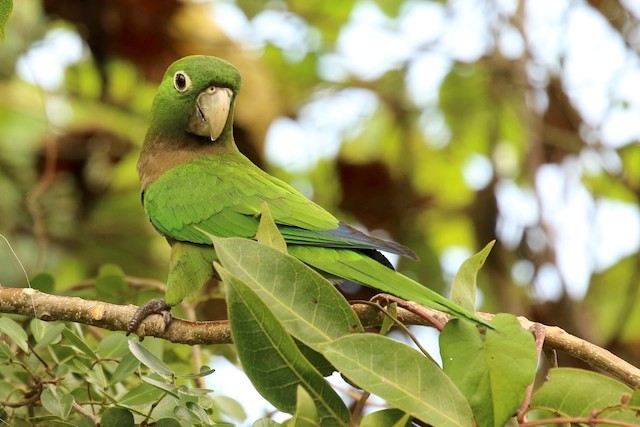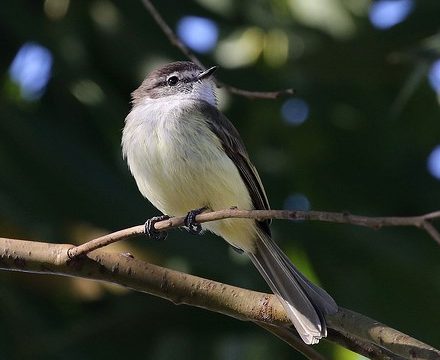San San, Jamaica
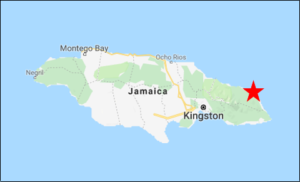
San San, the leafy seaside resort town and historical playground of the rich and famous east of Port Antonio, is an excellent destination for those who wish to combine a relaxed beach vacation with pursuit of Jamaican birds. In the dilapidated splendor of San San, the grounds of the hotels are productive habitats for specialty species including Ring-tailed Pigeon, Caribbean Dove, Chestnut-bellied Cuckoo, Jamaican Owl, Jamaican Mango, Black-billed Streamertail, Jamaican Parakeet, White-eyed Thrush, and most of the commoner endemics. The area has more than its share of natural beauty and attractions, but without the hedonistic hordes of tourists that descend on Montego Bay, Ocho Rios, and Negril.
Orientation
Directions
San San is about 15 minutes east of Port Antonio, which is a regional capital (of Portland Parish) and major port, on the main coastal highway, Route A4.
San San is about three hours’ drive (110 km) from Kingston, two hours (also 110 km) east of Ocho Rios, and four hours (200 km) east of Montego Bay.
Ecclesdown Road, arguably the best site overall for Jamaican endemics, is a 30-minute drive (20 km), so San San serves as a convenient base for exploring it.
Attractions
The coastline east of Port Antonio, including San San, is widely considered to be among Jamaica’s prettiest, an opinion most famously popularized by the actor Errol Flynn.
The world-famous Blue Lagoon, the setting of the movie by the same name, is in San San. Another local attraction popularized through film is Reach Falls, which was a shooting location for the movie Cocktail, reached via Ecclesdown Road.
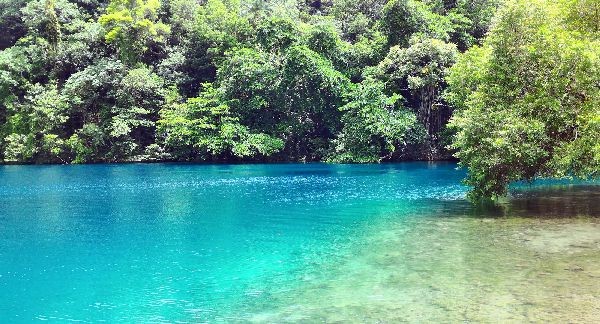
The Blue Lagoon, in San San.
Pleasant beaches in the area include Frenchman’s Cove, Winnifred, and Long Bay—a beautiful strip of sand that receives very few visitors.
Also nearby are Boston Bay, known for surfing and as the birthplace of jerk-style cooking, and the Rio Grande, where visitors can enjoy Errol Flynn’s favorite pastime of rafting downstream.
Before planning to visit the Blue Lagoon, Reach Falls, Boston Bay, or Port Antonio, it is a good idea to research them because, unlike San San itself, they present some of the annoyance typical of Jamaican tourist attractions.
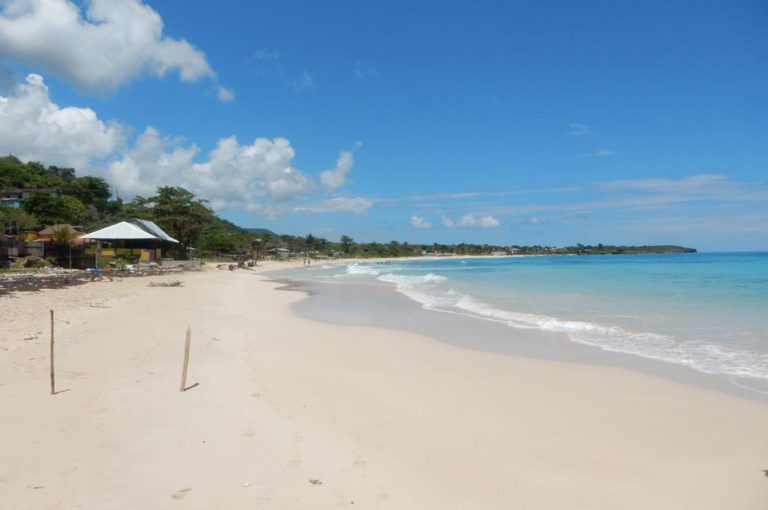
Long Bay Beach.
Birdfinding
Most of Jamaica’s endemic bird species can be found in San San. Its upscale approach to development has left the habitat largely intact, with lush hotel properties and winding hillside roads that provide convenient access. The highly localized endemic and spectacular Black-billed Streamertail is the commonest hummingbird in the area and can be found almost anywhere in San San.
To search for birds in San San, walk along one of the side roads that lead up into the hills. The three main alternatives are, from west to east, Mockingbird Hill, San San Police Station Road, and the Goblin Hill / Fern Hill area. Each has its merits, but the police station road is generally favored as it passes through more intact forest.

Male Black-billed Streamertail. © Li Li
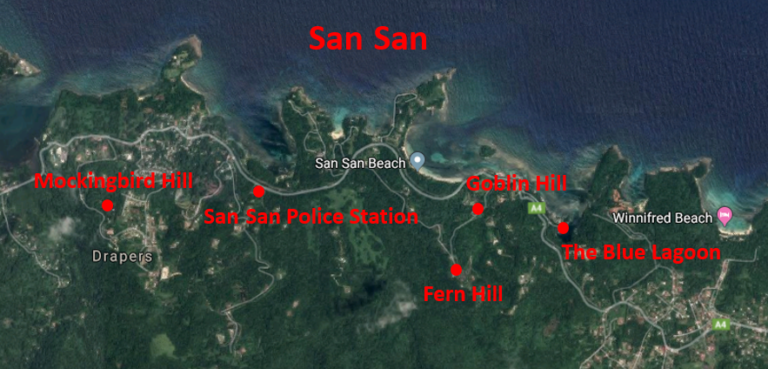
Favored spots in San San: Mockingbird Hill, San San Police Station Road, and the Goblin Hill / Fern Hill area.
San San Police Station Road. From the A4, about 500 m west of the turn-off to Frenchman’s Cove, turn uphill at the sign indicating the San San Police Station, then after 100 m turn left at the fork. Park in front of the small police station compound and continue on foot. The mostly disused road winds through the forest under a closed canopy, then through more open habitat where it leads up to a trio of isolated villas: Shoreham Green, Paradise Green, and Melarky.
The densely forested stretch is excellent for Jamaican Lizard-Cuckoo and White-eyed Thrush. Several other sought-after species are often seen in the open area farther up the road, including Ring-tailed Pigeon, Chestnut-bellied Cuckoo, Black-billed Streamertail, Green-rumped Parrotlet, Jamaican Parakeet, Small Jamaican Elaenia, Jamaican Becard, and Yellow-shouldered Grassquit, among others.
Most of the many pigeons flying overhead will be either White-crowned or Ring-tailed, but check them all. There have been sightings of Plain Pigeon, which was long unknown from eastern Jamaica, but may be is recolonizing this area.
Mockingbird Hill. Along the main coastal route, on the western edge of Drapers, about 200 m east of the Jamaica Palace Hotel, turn uphill at the sign indicating the Hotel Mockingbird Hill. This road passes a few large houses as it winds up the forested hill and eventually reaches the hotel and its restaurant, Mille Fleurs. If you are not staying at the hotel or dining at the restaurant, the staff may charge a fee to walk the grounds—or, alternatively, you can usually earn guest privileges by ordering a drink at the restaurant.
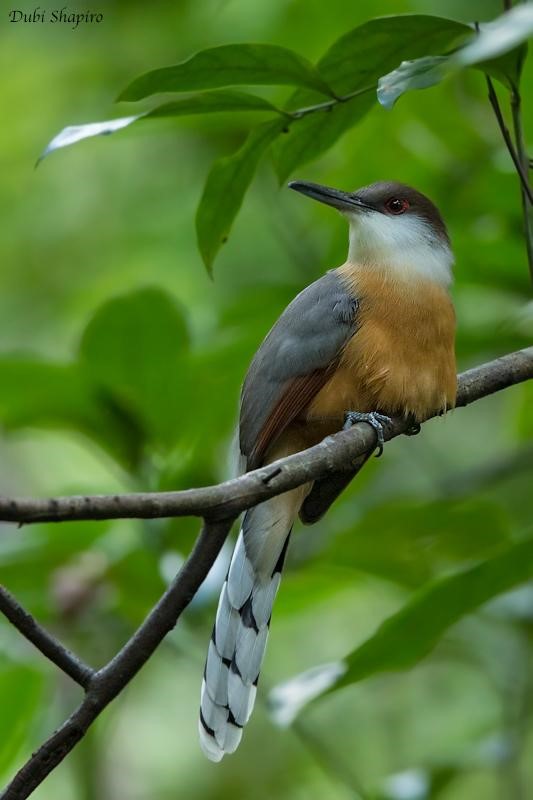
Jamaican Lizard-Cuckoo at San San. © Dubi Shapiro
The grounds of the hotel have been landscaped into a lush garden that provides excellent habitat and observation opportunities. All four of Jamaica’s hummingbird species visit the feeders and flowering bushes and trees, with Black-billed Streamertail predominating and Red-billed Streamertail just an occasional visitor. Walks around the grounds are likely to produce all of the common endemics, including Ring-tailed Pigeon, Chestnut-bellied Cuckoo, and Jamaican Parakeet. More localized species that sometimes occur include Caribbean Dove, Yellow-billed Parrot, and Small Jamaican Elaenia. The hotel is also known for having a resident pair of Jamaican Owls.
Goblin Hill and Fern Hill. Many of the same species noted for the sites above—including the hummingbirds and Jamaican Owl—can also be found along the roads up Fern Hill, including the grounds of Goblin Hill Villas. To reach this area, take the main coastal route to the east end of San San, past the main beach (San San Beach) and turn right before reaching the Blue Lagoon.
The hotel Goblin Hill Villas is on the right about 400 m up the road. If you are not staying at the hotel, you will have to ask at the front desk to walk the grounds. In any case, ordering a drink or some food at the restaurant should gain you some time with a view of the hummingbird feeders. Apart from the feeders, the hotel grounds give access to productive edge habitat, and Jamaican Owls have bred on or beside the property.
Continuing past Goblin Hill, the road climbs through similar edge habitat up to the Fern Hill Club and, like most side roads in San San, has only an occasional car passing by. Just before reaching the club, on the right is yet another road, Mile Gulley Road, that leads downhill to the west through mostly undisturbed habitat and rejoins the main coastal route at the San San Tropez Hotel.
Jamaican Owl. Jamaica’s endemic owl seems to be particularly numerous around San San, with pairs regularly nesting on or near the grounds of both the Hotel Mockingbird Hill and Goblin Hill Villas. Another nearby hotel property where the owl has been found is Frenchman’s Cove Resort, beside the parking lot. Be advised, however, that the owl is a mobile creature and is rarely guaranteed to show up at any of these locations.
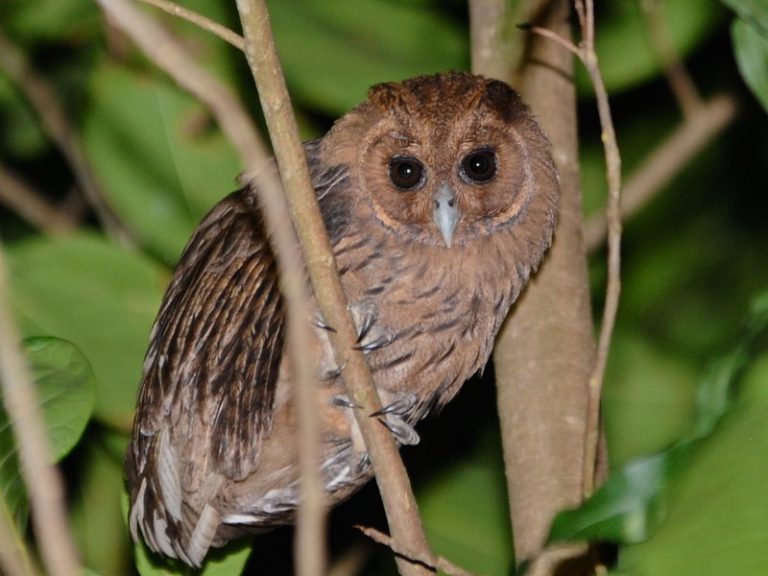
Jamaican Owl at Goblin Hill. © Alan Van Norman
Services
Accommodations
Port Antonio is a long-established tourist destination with a wealth of hotels, resorts, and guest houses. Most of the favored lodgings are east of the city center, in the attractive coastal strip that includes San San. The following list is not nearly comprehensive, but covers most of the mid-range options likely to suit a broad cross-section of ecotourists.
Just east of Port Antonio, in Anchovy Gardens, are two reasonably priced, comfortable hotels, the Bay View Eco Resort and the Match Resort, an envious stone’s throw from the palatial landmark Trident Hotel.
Continuing east, in Drapers, are: first, beside the water, the large, family-oriented Jamaica Palace Hotel, then, steeply uphill, the area’s original ecotourist magnet, the Hotel Mockingbird Hill, followed by two smaller budget options, Search-Me-Heart and the Drapers San Guest House.
East of Drapers, the fashionable San San district is a popular getaway for wealthy Jamaicans and foreigners who rent the private villas that dot its emerald hills. More affordable (but not cheap) accommodations in San San can be found at pleasant hotels including Frenchman’s Cove Resort the Goblin Hill Villas and San San Tropez.
At the eastern edge of San San, beside the Blue Lagoon, is a cluster of mid-range hotels, including Moon San Villa and the Tropical Lagoon Resort.
A little farther east, in Fairy Hill, a short walk from Winnifred Beach, Mikuzi Guest House is a bargain for those on the budget-conscious or bohemian end of the spectrum.
Food
Food is not San San’s strong suit. There are a handful of good restaurants, including those at the Hotel Mockingbird Hill and Goblin Hill Villas. In general, the default option of eating where you stay usually makes the most sense.
The fabled birthplace of jerk cuisine, the Boston Jerk Center, is on Route A4 beside Boston Beach, a 20-minute drive east of San San. The venerable Jerk Center is a cluster of artisanal barbecue pits under corrugated roofs near the site of the world’s first commercial jerk pit. Two of the current pits date back to the first generation: Ivy’s and Shaggy’s.
It is important for foreign visitors to know “that the way these Jerk centres charge customers are often unregulated and even discriminatory—specifically toward tourists. So the trick is to always ask the prices of things before you buy. And if you have no problem with this, all will be fine. Failure to do this will lead to them tricking you. You have been warned.” (Thanks to PrissyTroopers!)
Notes
While most of the San San area is blissfully peaceful, there are three nearby spots where Jamaica’s relentless hustlers lie in wait for tourists. The Blue Lagoon is notorious for its fleet of boatmen and their aggressive promotors, so it is unwise to stop there without a plan. Fortunately, most of the local hotels will be able to connect you with a recommended boatman, enabling you to brush off the promotors.
East of San San, Boston Beach is a picturesque cove with a sandy beach that gives access to surfable swells beyond the shoals. However, its reputation has suffered from the presence of aggressive hustlers who badger and sometimes threaten tourists to extract “go-away” money—but perhaps others in the community will find a way to address this problem.
In downtown Port Antonio, the area around the Errol Flynn Marina and the cruise ship pier is, unfortunately, not a safe place to wander. Unaccompanied tourists are nearly guaranteed to be harangued by panhandlers and hustlers.
